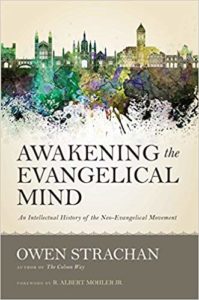
Awakening the Evangelical Mind: An Intellectual History of the Neo-Evangelical Movement
In the 1980s, I attended the Simon Greenleaf School of Law and Trinity Evangelical Divinity School. I knew that the professors under whom I sat at these two institutions— including John Woodbridge, Wayne Grudem, D. A. Carson, Gleason Archer, Harold O. J. Brown, Harold Lindsell, and Carl F. H. Henry—composed a remarkable list of evangelical scholars. Owen Strachan’s recent publication, Awakening the Evangelical Mind: An Intellectual History of the Neo-Evangelical Movement, not only makes me appreciate this stellar group even more, but also provides a strong contextual framework for the origins, efforts, and accomplishments of a twentieth-century movement whose goal was nothing less than the transformation of Christianity and Christian thinking.
At the center of Strachan’s brief survey of neo-evangelicalism are a number of key individuals, including a group he labels the Cambridge evangelicals, those who studied primarily at Harvard in the 1930s and 1940s and then dispersed to influence American Christianity with their teaching and writing. These doctrinally conservative students desired to make Christianity intellectually respectable and to transform their culture, rather than retreat from society as was the pattern with fundamentalism in the 1920s and 1930s. Strachan writes, “For the Cambridge evangelicals, head and heart worked in tandem, symbiotically, to produce a life that won glory to God and left a mark on a fallen world” (121). If the center of Strachan’s story is this cohort of evangelicals who formed the backbone of new institutions like Fuller Seminary and Christianity Today, the heart of the movement was two key individuals, Carl F. H. Henry and Harold Ockenga, especially the latter.
Strachan’s portrayal of Ockenga sometimes borders on adulation, but his inclusion of this Christian preacher and leader is a crucial missing link in the oft-told story of the evangelical movement. Strachan has dug deeply into the archives to present us a picture of a young man who wanted to be more than a pastor, even giving us glimpses of Ockenga’s college papers and notes he took on sermons to which he listened. Ockenga pursued the life of the mind as a student in the 1920s and 1930s, becoming a protégé of J. Gresham Machen and graduating from Machen’s newly formed Westminster School of Theology in 1931. Harold Ockenga’s lifelong dream was to inspire his generation and those who would follow with an intellectually respectable Christianity that could confront and change a culture that was increasingly liberal and secular. Ockenga earned a Ph.D. at the University of Pittsburgh, and then his influence grew almost exponentially when he took the pastorate of the Park Street Church in Boston; it was there that his preaching began to reach the Cambridge evangelicals. While in the Park Street pulpit, Ockenga formed relationships with emerging evangelical scholars such as Henry, Edward John Carnell, Kenneth Kantzer, and George Eldon Ladd, as well as with the most popular evangelical figure of the day, Billy Graham. These relationships led to the creation of a number of evangelical establishments, including the National Association of Evangelicals, Fuller Seminary, the Evangelical Theological Society, and Christianity Today.
The partnership of Ockenga with Carl Henry is an important component of the story of the neo-evangelicals that Strachan outlines. Ockenga was the gifted leader, speaker, and organizer, and Henry, as Strachan explains, was an intellectual giant. Henry’s publications, especially The Uneasy Conscience of Modern Fundamentalism, inspired and, because of his desire to change the mindset of what he saw as a complacent Christianity, sometimes ruffled the feathers of the Christian community. Both men desired to break from the confines of fundamentalism and to champion a Christianity that had intellectual rigor. Strachan notes,
In Ockenga’s writings and Henry’s book we observe a striking confluence of strategy and ideas. Both evangelical leaders championed a full-scale educational program characterized by engagement with nonevangelical thought and confidence in the ability of Christian institutions to sustain such engagement. (110-111)
Ockenga, in partnership with Henry, served as the first president in absentia of Fuller Theological Seminary, whose charter goals included becoming an academic powerhouse and recapturing the nation for the cause of Christ.
One of the most fascinating chapters of the book recounts Carl Henry’s failed attempt to found a Christian liberal arts institution that would be the equal of the Ivy League schools. Henry worked with Ockenga, with Graham, and with a host of potential sponsors and donors into the 1970s to see his vision realized. Though Crusade University never came to fruition, Strachan uses the episode as an example of how far-reaching the goals of the neo-evangelicals were well into the second half of the twentieth century. And interestingly, according to Strachan, it was not strictly money that hindered the success of Henry’s dream. Rather, it was the question of geographical location and the question of how stringent to make the student code of conduct.
It is in this chapter on failed dreams that one senses perhaps most clearly the lessons Strachan is trying to highlight from the story of the neo-evangelical movement. This story is at the same time an encouragement to dream large and a cautionary tale that dreaming large can lead to a sobering dose of reality. There are striking examples of individuals who refused to give in to the tide of modernism and secularism or to retreat from modernism into isolated Christian niches, as the fundamentalists did. Those like Henry, Carnell, Graham, and Ockenga believed in meeting the challenges that faced Christianity without compromising ideas or intellect. As a result of their passion and vision, we can look back at a heritage of robust Christian scholarship and influence that extends to the present day. Although Dr. Henry was quite old by the time I sat in his theology class at TEDS, and though his voice would typically waver as he got underway on a given day, I also came to expect moments in his lecture when his voice would strengthen and his energy would magnify–Strachan’s story has given me a better context to understand those moments.
But a cautionary tale emerges as well. The neo-evangelicals could not agree on issues like moral codes of conduct, and, more importantly, on even more central issues like the view of Scriptural authority–a view that helped fracture the missional direction at Fuller by the 1970s. Strachan, however, uses his insightful overview of the neo-evangelical movement to provide mostly optimistic lessons: that institutions are valuable, that dreams are important even if they may not always be realized, and that the life of the mind is always a worthy calling for Christians desiring to make an impact in their world.























